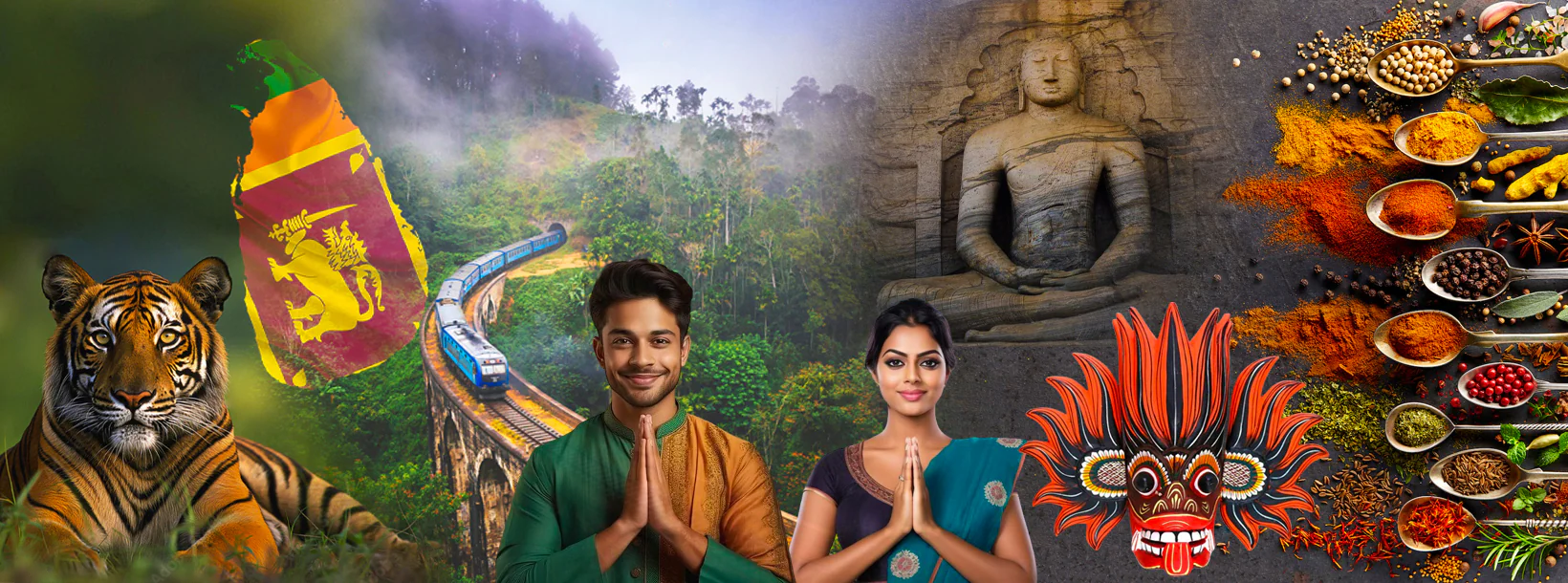
Sri Lanka
Sri Lanka, an island nation in South Asia, is renowned for its rich cultural heritage, diverse landscapes, and wildlife. Attractions include ancient temples, pristine beaches, lush tea plantations, and vibrant festivals. The country's unique blend of cultures, warm hospitality, and delicious cuisine make it a captivating destination for travelers.
Ceylon
During World War I (1914–18) the forces of nationalism in Ceylon gathered momentum, propelled largely by civil disturbances in 1915 and subsequent political repercussions. British arrests of prominent Sinhalese leaders during what was at first a minor communal riot provoked widespread opposition. Leaders of all communities, feeling the need for a common platform from which to voice a nationalist viewpoint, came together in 1919 to form the Ceylon National Congress, which united Sinhalese and Tamil organizations. In a series of proposals for constitutional reforms, the Congress called for an elected majority in the legislature, control of the budget, and partial control of the executive branch.
A new constitution was promulgated in 1920 under the governor Sir William Manning, and in 1924 it was modified to satisfy nationalist demands. The revised document provided for an elected majority in the legislature, an increase in the number of territorially elected members, and the election of communal representatives. Ceylon thus attained representative government. A finance committee of the legislature, consisting of three unofficial and three official members, also was formed; the committee had the authority to examine the budget. However, no major concessions were made in the executive branch, which remained under the British governor and the official Executive Council.
The allowance of greater power to the nationalists produced the first fissures among them. While Sinhalese leaders wanted to do away with communal representation and make territorial representation universal, minorities aimed to retain it to secure power for their own communities. Minorities broke away from the Congress to form their own organizations.
A new constitution, framed in 1931 on the recommendations of a commission appointed to examine constitutional reform, gave Ceylonese leaders opportunities to exercise political power and to gain governmental experience with a view toward eventual self-government. It provided for a State Council with both legislative and executive functions. In addition to being a legislative council with an overwhelming majority of territorially elected members, the State Council was divided for executive work into seven committees, each of which elected its own chairman. These chairmen, or ministers, formed a board of ministers to coordinate the activities of the council and to present an annual budget. The constitution, which remained in effect for more than 15 years, also granted universal suffrage, thus bringing all Ceylonese into the democratic political process.
Social and cultural changes
Economic development and the spread of education brought about changes in society, including changes in the relationships between social groups. Upper elements of the dominant castes solidified their positions by taking advantage of new developments. Castes traditionally of lower status also made use of these opportunities to move upward, creating tensions within the caste system. A community of capitalist entrepreneurs and professionals who were proficient in English emerged as a new class that transcended caste boundaries. Generally referred to as the “middle class,” this group produced the leaders of many political and social movements in the 20th and 21st centuries.
Dominion status
In response to Ceylonese nationalist leaders—who exerted pressure behind the scenes while cooperating with British efforts during World War II (1939–45)—the British in 1944 appointed the Soulbury Commission to develop a new constitution for Ceylon. The Soulbury constitution gave the colony internal self-government but retained some imperial safeguards in defense and external affairs. In 1947 the Ceylon Independence Act conferred dominion status on the colony, whereby Ceylon was recognized as an autonomous entity with allegiance to the British crown.
Ceylon held elections for the parliament outlined in its new constitution in August 1947, shortly after its acquisition of dominion status. The United National Party (UNP), a coalition of a number of nationalist and communal parties, won the majority; it chose Don Stephen Senanayake as prime minister and advocated orderly and conservative progress. The UNP was dominated by the English-educated leaders of the colonial era, who were familiar with the British type of parliamentary democracy that had been established on the island, and it included people from all the ethnolinguistic groups of Ceylon. Its members were bound by the common ideals of Ceylonese nationalism, parliamentary democracy, and gradual economic progress through free enterprise.
Independent Ceylon (1948–71)
Actual independence for the dominion of Ceylon came on February 4, 1948, when the constitution of 1947 went into effect. The constitution provided for a bicameral legislature with a popularly elected House of Representatives and a Senate that was partly nominated and partly elected indirectly by members of the House of Representatives. A prime minister and his cabinet, chosen from the largest political group in the legislature, held collective responsibility for executive functions. The governor-general, as head of state, represented the British monarch. In matters that the constitution failed to address, the conventions of the United Kingdom were observed.
The UNP had a substantial majority in the legislature and attracted support as it governed. There were, however, some basic weaknesses in the political structure. The consensus that the government represented embraced only a small fraction of the population—the English-educated Westernized elite groups that shared the values on which the structure was founded. To the great mass of Sinhalese- and Tamil-educated residents and unschooled citizens, these values appeared irrelevant and incomprehensible. The continued neglect of local culture as embodied in religion, language, and the arts created a gulf that divided the ruling elite from the ruled. Inevitably, traditionalist and revivalist movements arose to champion local values.
The island’s three export products—tea, rubber, and coconuts—were doing well in world markets, providing some 90 percent of foreign exchange earnings. Nevertheless, the country began to face economic difficulties. A rapidly increasing population and the free import of consumer goods swiftly ate into earnings from foreign trade. The falling price of Ceylon’s rubber and tea and the increase in the price of imported food added to the acute foreign exchange problem. Additionally, the expanded school system produced a large number of educated persons who could not find employment.
The various factors of political and economic discontent converged after 1955, and a new Sinhalese nationalism was unleashed. It found a spokesman in S.W.R.D. Bandaranaike. In the 1956 elections the UNP was defeated, and Bandaranaike’s Sri Lanka Freedom Party (SLFP) came to power. The new government immediately set about changing the political structure. With the Sinhala Only Bill, it made Sinhalese the sole official language, and it took measures to provide state support for Buddhism and for Sinhalese culture. It also wedded the new nationalism to a form of socialism, in which the state was given a powerful role in economic development and the creation of economic equality.
The various factors of political and economic discontent converged after 1955, and a new Sinhalese nationalism was unleashed. It found a spokesman in S.W.R.D. Bandaranaike. In the 1956 elections the UNP was defeated, and Bandaranaike’s Sri Lanka Freedom Party (SLFP) came to power. The new government immediately set about changing the political structure. With the Sinhala Only Bill, it made Sinhalese the sole official language, and it took measures to provide state support for Buddhism and for Sinhalese culture. It also wedded the new nationalism to a form of socialism, in which the state was given a powerful role in economic development and the creation of economic equality.
Bandaranaike was assassinated in September 1959, and the nationalist movement suffered a setback and languished for want of a leader. After a period of political instability, his widow, Sirimavo Bandaranaike, was persuaded to gather together the fragments of the SLFP. In 1960 she formed a government, thus becoming the first woman in the world to hold the office of prime minister. Continuing the program of Sinhalese nationalism, she implemented policies to nurture and protect local industry and to extend the state sector. Partly in response to pressure from the Buddhist community to reduce the prominence of Christian missions in the country’s educational system, most private schools were nationalized, and state subsidies to any remaining private schools were discontinued.
By 1965 the tide of Sinhalese nationalism had begun to recede. Language and religion had become less important as political issues. An economic crisis—caused by increasing unemployment, the rising cost of living, an acute shortage of consumer goods, and the failure of state enterprise in industry and trade—made people look back to the UNP. This party gained the support of minorities, and in 1965 it returned to power under Dudley Shelton Senanayake, who, as the son of Don Stephen Senanayake, had served as prime minister (1952–53) after his father’s death and briefly in 1960. Senanayake’s government enjoyed a five-year term of office, during which it encouraged private enterprise and made an effort to extend agricultural productivity. These measures, while having moderate success, also tended to create inflation and to increase social inequality. The SLFP formed an alliance with Marxist parties and waged a campaign against the government that called for increased state control of the economy. In 1970 this coalition won a landslide victory, and Sirimavo Bandaranaike again became prime minister.
The Bandaranaike government enacted reforms that restricted private enterprise and extended nationalization to embrace various private industries and foreign-owned plantations as well as a large part of the wholesale and distributive trade. Measures aimed at reducing social inequality were enacted, and an ambitious program of land reform was put into effect. Although these reforms benefited the vast majority of the underprivileged, they did nothing to address basic economic problems such as the mounting trade deficit. The educated youth, impatient for radical change, became disillusioned. Their discontent was mobilized by the People’s Liberation Front (Janatha Vimukthi Peramuna; JVP), a group of revolutionary youth who launched an unsuccessful armed rebellion in 1971.
The Republic of Sri Lanka
In a new constitution proclaimed in 1972, Ceylon became the Republic of Sri Lanka, while maintaining its link with the British Commonwealth. The constitution changed the bicameral legislature to a unicameral body and replaced the governor-general (who had been an extension of the British crown) with a president as head of state. Effective executive power, however, remained with the prime minister and cabinet, and all existing restraints on the lawmaking powers of the new unicameral legislature were removed. Buddhism was given “the foremost place,” and Sinhalese again was recognized as the official language.
As Sri Lanka’s economic decline continued, the immense economic power held by the state provided the party in power with the opportunity for patronage, nepotism, and corruption. By 1977 unemployment had risen to about 15 percent. In July of that year the SLFP was defeated by a reorganized UNP under the leadership of J.R. Jayawardene, who became prime minister.
The Jayawardene government sought to reverse trends toward state control of the economy by revitalizing the private sector and attracting foreign capital. It also set about writing a new constitution, promulgated in 1978, which renamed the country the Democratic Socialist Republic of Sri Lanka and introduced a system under which the president remained head of state but was given new executive power as head of government. Although Sinhalese and Tamil were recognized as the national languages, Sinhalese was to be the official language. In 1978 Jayawardene was elected the first president under the new constitution, and Ranasinghe Premadasa, also of the UNP, became prime minister.
Civil war
However, political unrest escalated in the 1980s as groups representing the Tamil minority moved toward organized insurgency. Tamil bases were built up in jungle areas of the northern and eastern parts of the island and increasingly in the southern districts of the Indian state of Tamil Nadu, where Tamil groups received official and unofficial support. The Liberation Tigers of Tamil Eelam (LTTE)—popularly known as the Tamil Tigers—was the strongest of these, but there were other competing groups, which were sometimes hostile to each other.
The Sri Lankan government responded to the unrest by deploying forces to the north and the east, but the eruption of insurgency inflamed communal passions, and in July 1983 there were extensive organized anti-Tamil riots in Colombo and elsewhere. Sinhalese mobs systematically attacked Tamils and destroyed Tamil property, and the riots forced refugees to move within the island and from Sri Lanka to Tamil Nadu.
Peace accord and discord
The Jayawardene government, facing a simultaneous resurgence of Sinhalese militancy by the JVP, became receptive to initiatives by the Indian government. After prolonged negotiations, an accord signed between India and Sri Lanka on July 29, 1987, offered the Tamils an autonomous integrated province in the northwest within a united Sri Lanka. Later that year, Tamil was recognized as an official language (alongside Sinhalese) by constitutional amendment. Meanwhile, the accord provided for the introduction of an Indian Peace-Keeping Force (IPKF) to enforce the terms of the agreement. However, the Sri Lankan government, the LTTE, and the IPKF disagreed over implementation of the accord, and the LTTE resumed its offensive, this time against the IPKF, which was trying to disarm it.
In January 1989 Jayawardene retired and was succeeded by Premadasa, who had defeated Sirimavo Bandaranaike in the December 1988 elections. Premadasa negotiated a withdrawal of the IPKF, which was completed in March 1990, and the battle against Tamil insurgency was taken up by the Sri Lankan army. On May 1, 1993, Premadasa was assassinated by a suicide bomber, who allegedly was linked to the LTTE. The prime minister, Dingiri Banda Wijetunga, was appointed acting president. In 1994 Chandrika Kumaratunga, the daughter of S.W.R.D. and Sirimavo Bandaranaike, became the country’s first female president. Rebel activity continued, and in 1999 Kumaratunga was injured in an assassination attempt blamed on the LTTE. She won reelection later that year. In 2002 a landmark cease-fire was negotiated between the war-weary LTTE and the government. Within just a few years, however, violence had resumed, and the cease-fire had virtually dissolved.
In addition to struggling with ongoing political unrest in the early 21st century, Sri Lanka was rattled by a tremendous natural disaster. In December 2004 the island was struck by a large tsunami that had been generated by an earthquake centred in the Indian Ocean near Indonesia. The wave killed tens of thousands of people and severely damaged the country’s northern, eastern, and southern coastal areas. Recovery was steady in the eastern and southern zones but was slower in the north because of the ongoing conflict there.
End of the war
Meanwhile, in 2005 Mahinda Rajapaksa, known for his strong stance against the LTTE, was elected president as head of a broad coalition of parties called the United People’s Freedom Alliance (UPFA), which had gained a plurality of legislators in parliamentary elections the previous year. The conflict between the Tamil rebels and the government raged on, and in 2006 the LTTE was declared a terrorist organization by the European Union. In January 2008 the government formally abandoned the 2002 cease-fire agreement, and the fighting intensified. Over the following months, the government captured major strongholds of the LTTE. The town of Kilinochchi, the administrative centre of the LTTE, came under government control in January 2009. Government troops continued their advance into LTTE-controlled territory, cornering the remnants of the rebel fighters along the northeast coast by late April. The army launched a final offensive in mid-May and succeeded in overrunning and occupying the rebels’ last stronghold. The LTTE’s leaders (including founder Vellupillai Prabhakaran) were killed during the operation, and the LTTE effectively ceased to exist as an organization. The number of civil-war-related deaths in Sri Lanka since the early 1980s was estimated at between 70,000 and 80,000, with many tens of thousands more displaced by the fighting.
Aftermath and recovery
The government’s victory over the LTTE was highly popular with the country’s Sinhalese voters, and the UPFA won several provincial and local elections during 2009. However, in the January 2010 presidential election, Rajapaksa faced stiff opposition from Sarath Fonseka, the former general who had commanded the Sri Lankan military during the civil war. Rajapaksa won a second term, although the results were challenged by Fonseka. In early February Fonseka was arrested while discussing with members of the opposition the upcoming April parliamentary elections. The charges against him allegedly stemmed from events before his retirement as general. Rajapaksa dissolved Parliament the following day. In the April legislative elections, UPFA candidates won a majority of seats, and in September Parliament voted to amend the constitution to give the president greater powers and also to remove the restriction that a president could serve for only two terms.
Reconstruction
Sri Lanka began to recover from its 26-year civil war during Rajapaksa’s second term. The economy showed sustained growth and reduced poverty levels, though some were concerned about ballooning debt and overreliance on foreign investment, especially from China. The government continued to enjoy the strong support of the country’s large Sinhalese majority, which was reinforced by a string of UPFA victories in provincial council elections in 2012. Rajapaksa’s administration, however, became increasingly associated with strong-arm tactics and other repressive measures against political opponents and various forms of dissent, as he centralized greater power in the executive branch and among his family members. A key development project was an expensive port in his home district of Hambantota, funded by loans from China but which had low returns on investment. In addition, relations with Western countries were strained over allegations of human rights abuses in Sri Lanka and the government’s refusal to allow independent investigations of the military’s treatment of Tamils at the end of the civil war in 2009.
Rajapaksa’s domestic popularity appeared to wane during 2014, as UPFA candidates won by considerably smaller margins in local elections than they had two years earlier. Late in the year he again called for an early presidential election, confident that he would easily win a third term if he held the election ahead of schedule. Unexpectedly, however, one of his cabinet members, Maithripala Sirisena, defected to the opposition and ran against him. Other UPFA members defected as well. In the early January 2015 polling, Sirisena scored an upset victory over Rajapaksa and was sworn in as president.
In April 2015 Parliament amended the constitution to restore the presidential two-term limit that had been removed in 2010. Having won the most seats in parliamentary elections held on August 17, the UNP formed a six-party coalition government. In June 2016, along with acknowledging that some 65,000 people who had gone missing during the civil war remained unaccounted for, the government approved legislation providing for the issuance of certificates of absence to the families with missing relatives, thereby allowing them to finally settle issues of inheritance, guardianship, and other related matters.
Country in crisis: growing debt, political wrangling, and terror attack
The country’s enormous debt led to a balance-of-payments crisis in 2016. The government arranged a $1.5 billion bailout with the International Monetary Fund (IMF) and set out to increase its tax revenue. It continued to have difficulty paying its debt, however, and found itself falling more indebted to China. In 2017 Sri Lanka leased its newly built Hambantota port to China for 99 years, and in 2018 it accepted a $1 billion loan from China to help repay maturing loans.
As the economy struggled to sustain growth amid the debt crisis and as political tensions brewed, Sirisena fired his prime minister, Ranil Wickremesinghe, and appointed Rajapaksa in his place in October 2018. Wickremesinghe charged the move as unconstitutional and refused to step down. When it became clear in early November that Rajapaksa did not have Parliament’s support, Sirisena attempted to dissolve Parliament and call for early elections. Days later the move was suspended by the Supreme Court until it could rule on the legality of Sirisena’s action, thus allowing Parliament to convene and pass two votes of no confidence against Rajapaksa. The votes were rejected by Rajapaksa and his allies, and he continued to argue that he was the legitimate prime minister. After the Supreme Court ruled in early December that Sirisena could not dissolve Parliament, Rajapaksa stepped down to avoid further stalemate, and Sirisena reappointed Wickremesinghe.
Months later the country was shaken by its worst violence since the civil war. On April 21, 2019—Easter morning—eight explosions occurred in the vicinity of churches and hotels, leaving hundreds dead and hundreds more wounded. Another blast occurred near a church the next day, while other explosive devices were discovered and neutralized before being detonated. Authorities, who had been warned about the attack about two weeks in advance, identified a little-known Islamist militant group as the orchestrator of the attacks. The manner and sophistication of the attacks, however, suggested involvement from international networks. In the days that followed, the Islamic State in Iraq and the Levant (ISIL; also called ISIS) claimed responsibility, though the waning organization offered no evidence of its direct involvement.
As the presidential election approached later that year, Sri Lankans were cognizant of the outgoing government’s ineffectiveness in addressing the debt crisis, its political instability, and its inability to prevent the Easter attacks. For many Sinhalese, Mahinda Rajapaksa and his brother Gotabaya offered a promise of progress, stability, and security. In November Gotabaya was elected to the presidency along ethno-religious lines—he lacked support from Tamil and Muslim voters, who were fearful of restoring to power a family known for its brutality in the civil war. Days after taking office, Gotabaya appointed Mahinda to be prime minister.




